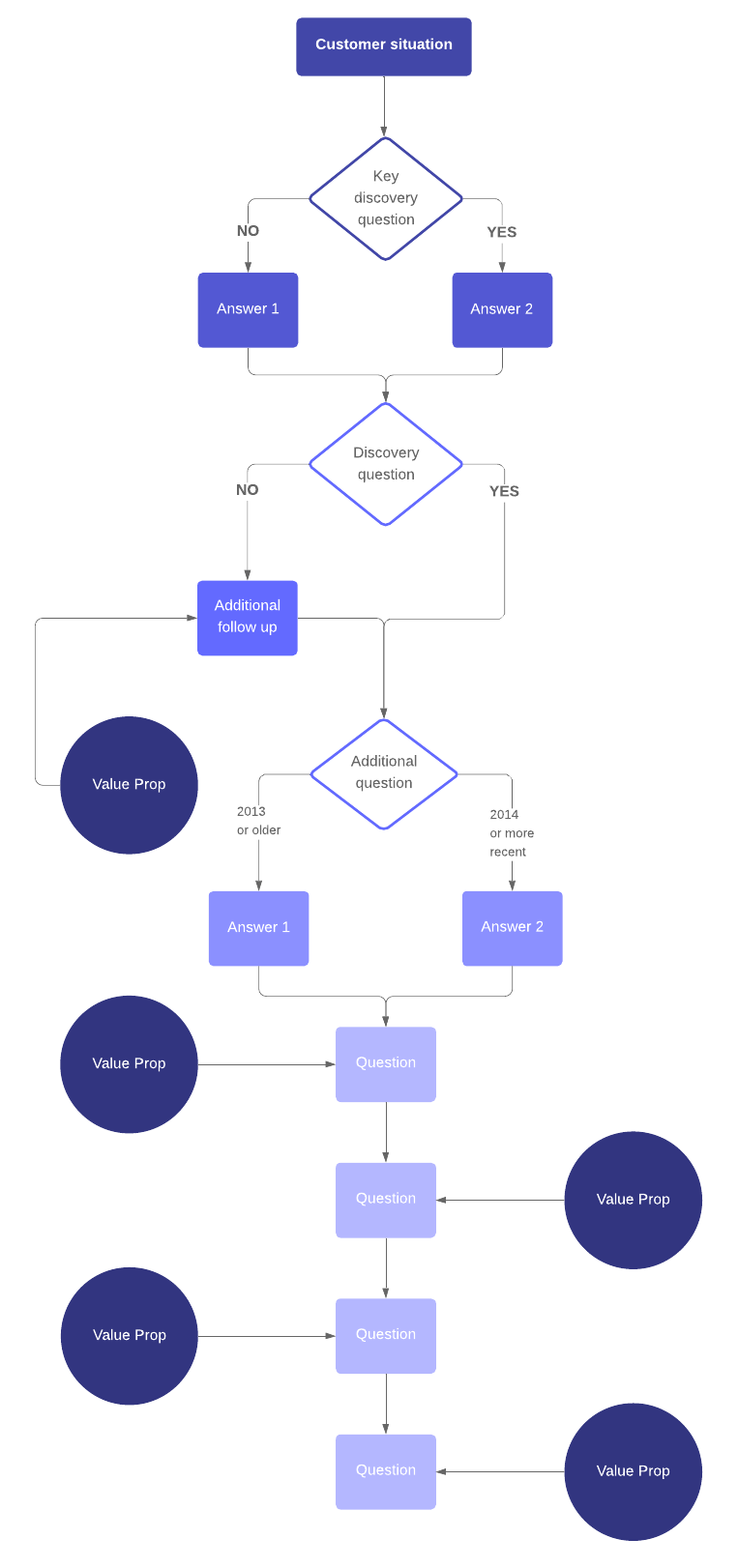
Why mastering the discovery call is key to improving the buyer experience
Taylor Dolbin
Reading time: about 10 min
Topics:
When a prospect agrees to schedule a discovery call with your sales team, they’re obviously interested in what you’re selling.
Think about that for a moment: Your prospect is bombarded with pointless pitches and useless marketing messages, but for some reason, they’ve decided your company might have what they’re looking for.
A discovery call is more than the first conversation between a sales rep and a prospect. Indeed, it can be a gold-plated opportunity—if you can keep the call from going off the rails.
Why the discovery process is so important to buyer experience
It’s not enough to present your product or service as the solution to prospects’ problems. You have to make a connection to their innermost emotional challenges.
Today’s buyers have access to an unprecedented volume of information. They’re savvier, and they have more options than ever before. During the sales cycle, the prospect’s tipping point often comes down to how well they feel understood—and how well your solution speaks directly to their needs.
So, make sure your discovery process captures the prospect’s perspective: They get dozens of voicemails and emails every day trying to grab their attention. Most of these messages are worthless because they aren’t relevant to what the prospect needs right now, and you have to make sure your message doesn’t similarly get lost in the shuffle.
Imagine the IT director who’s under fire for an embarrassing breach of customer data. If you’re selling an automated backup solution, you have to frame your discovery call to establish that your technology helps him address the threat of a cyber-attack. Otherwise, you’re doing the prospect no good.
The discovery call is your reps’ first chance to elevate the buyer experience. If they get it right, sales reps will learn the prospect’s core motivations and be able to demonstrate how they can solve the buyer’s most pressing problems.
Tips for mastering the sales discovery call
A robust discovery process includes asking probing questions to uncover the full scope of the prospect’s difficulties. These are some of the best ways to help your sales org master the sales discovery call and optimize the buying experience:
Do your homework
As you coach reps, instruct them to dig deep into the company’s market and figure out their most pressing challenges. They should visit the prospect’s LinkedIn page and look for opportunities to establish a personal connection, like congratulating them on a promotion or mentioning how much you enjoyed visiting their hometown.
Create a framework
Make sure your discovery process has a consistent structure, with bullet points that must be covered in a specific order that’s most friendly to the prospect’s point of view. Create a diagram, such as a conversation tree, to visualize your framework so everybody can understand it quickly and intuitively.

Document, measure, and test
Establish a base methodology to track the success of your discovery calls. Use the base data to establish benchmarks and best practices. Consider A/B testing to tweak your discovery process and improve performance. Many sales teams create scoring systems to help quantify their success rate.
As you optimize your discovery call methodology, always make sure you’re fine-tuning it in ways that create a better buyer experience. Success here depends on the quality of the questions that sales reps ask.
The best sales discovery questions to ask
In sales, you have to avoid your instinct to focus on your need to close. Instead, you want to learn why your prospect is interested in your company—their goals, challenges, and hopes that your solution can help them achieve. A customer-centered approach to the discovery call means asking a lot of questions and listening carefully to everything the prospect says in reply.
As you record and listen to discovery calls for reps to provide feedback, pay attention to the questions they ask—they shouldn’t bother with rookie questions like “What are your pain points?” and “What keeps you up at night?” Remember, prospects are talking to your competitors and expect you to understand why they’ve invited you into their world. It’s not what’s in it for you. It’s what you have for them.
Instead, coach reps to ask questions like, “Everybody in your market has the same problem—what if you could do X to solve it?”
Sales discovery questions should stay open-ended and exploratory. Sales reps don’t learn much from a “yes” or “no” reply. A few more examples:
- What’s going right with your current solution, and what’s going wrong?
- What do you think will happen if you do nothing and keep things the way they are?
- What would you like to do if budget were no object?
Your goal is to create a discovery call framework that asks similar questions of every prospect, so you can optimize your process to improve closing rates.
What to listen for after discovery call questions
Even more important than asking the right questions, sales reps need to listen intently to the answers buyers give in order to understand where they are coming from. The discovery call should reveal:
Where they are now
Sales reps should use conversations with other customers to probe how the prospect deals with common challenges in their marketplace. Reps could say something like, “Folks we’re talking to these days keep running into Problem X. How are you dealing with it?”
Where they want to be
One of the most essential questions is “What will success look like for you?” Reps have to understand the buyer’s target outcome to have any hope of helping them get there.
What unique business challenges they face
Each company has a distinct combination of clientele, leadership, management, and differentiation in the marketplace. Make sure discovery questions uncover how these qualities create unique problems your company can solve. Reps could ask questions like, “What’s different about your company that requires a unique approach?”
What they need from you
Make sure reps are clear on the specifics of what the buyer needs and what they object to. Your discovery call framework can help establish the most effective responses to their objections.
Who makes the buying decisions
The prospect probably doesn't have sole purchase authority. Make sure discovery questions reveal the key stakeholders in the buying process.
Don’t overlook the basics: Discovery questions also need to reveal the prospect’s budget, implementation timelines, and expected deliverables.
Building a relationship
Business always comes down to people buying from people. Thus, the discovery call should nurture opportunities to establish a personal bond with the prospect.
Salespeople often feel tempted to jump right into a product demo or a list of key features. That’s putting the cart before the horse. The prospect isn’t ready to buy during the discovery call. Instead, they’re trying to narrow their list of seven providers to two or three.
At this point, sales reps need to start probing the emotions that underscore the prospect’s motivation to work with them. They should ask questions that reveal how the buyer feels about the situation they’re in. Is it anxiety or determination? Do they have an adventuresome streak, or are they more cautious?
What do they need from salespeople throughout their buying process? What must you do to accommodate those needs?
Advise reps to apply a dash of small talk early in the call to establish that they’re an approachable person who’s interested in the prospect’s point of view. But remember that a gift of gab can be a double-edged sword: If they get carried away with the banter, they lose precious time to get on with the business of discovering the prospect’s needs.
Ultimately, all sales come down to an emotional response called trust. If logic and reason ruled the sales process, every provider could enter all their facts into a database and each customer could crunch numbers to determine the optimum solution.
Thus, your sales discovery process should be optimized to build a trusting business relationship.
Building relationships with potential buyers is easier said than done. See how to improve this skill during the discovery call.
Learn moreAfter the discovery call: Don’t fumble the handoff
When the discovery call goes well, the caller and the prospect put the wheels in motion for more calls to put both sides on the path to a sale.
It’s all good with one exception: After the discovery call, the sales rep usually has to hand information off to business-development reps, account executives, client services managers, and many others who must come into the sales process.
The challenge here is that everybody on the sales team needs access to discovery call information. If they can’t get it, then the handoff becomes a buyer experience fumble.
Why? Because prospects have to explain the same litany of challenges over and over—to all your people and many other vendors. Nobody likes a botched handoff. At best, they grit their teeth and put up with it.
If the rest of your sales team cannot access discovery call information, it's more difficult for them to understand the prospect’s needs and create customized solutions that make your product/service invaluable to the client.
Thus, improving internal sales communication and preventing a bad handoff—and the grumbling it causes—is a great way to optimize the discovery call, elevate your buyer experience, and differentiate yourself from the competitors who keep imposing these pain points on their prospects.
Here’s how to make that happen:
- Create a methodology to document discovery call insights and store them in a central location that key people can access before talking to prospects.
- Make it easy for your discovery call rep to take detailed notes explaining all the key knowledge learned during the call. Create a template, a cheat sheet, or an online form to gather and centralize discovery call information.
- If you have a CRM (customer-relationship management) platform, make sure to attach the results of your discovery call to the client account and to the prospect’s file.
When all the key people in your sales process know all the key facts about the prospect, they can expedite calls and talk to more prospects, potentially improving sales volume.
A solution for handoff challenges
Lucidchart has the tools to eliminate the risk of a poor sales handoff. This visual workspace includes a Salesforce integration that allows users to import contacts and develop account maps revealing all the key people in their sales processes.
Account maps allow sales reps to visualize the political landscape of a company and reveal all of the key stakeholders. And, most crucially, all the insights from the discovery call can be included within the account map.

Visualizing the connections between sales contacts makes it easier to make sense of the sales process. These connections are crucial because you're not simply selling to one person: You’re creating consensus among multiple stakeholders.
With the integration, all account maps are centrally stored and managed in Salesforce, so anyone with access to an account record or opportunity will have access to that account map and be able to quickly understand a deal’s status.
Account maps can also:
- Show how each contact feels about the product. Are they a champion? Do they like a competitor better?
- State the contact’s goals, so the sales team knows how to better sell to them or get the company to adopt your product more widely.
- Help your salespeople make quicker, smarter decisions that optimize your sales operations.
Armed with the knowledge from a discovery call, salespeople can strengthen the emotional connections between buyers and sellers.
Everything in sales flows from an effective discovery call. Fine-tuning these calls to enhance the buyer experience makes your sales organization more efficient and gets solutions into your customers’ hands sooner.

Use Lucidchart to visualize and share the information you learn during discovery calls.
Sign up nowAbout the author

Taylor Dolbin graduated from BYU in English and works as the Sales Solution Strategist at Lucidchart. His key focus is empowering sales organizations to sell more effectively. His greatest passions are trail running, triathlons, dirt biking, and being a husband and father to two (sometimes more, sometimes less) foster children.
About Lucidchart
Lucidchart, a cloud-based intelligent diagramming application, is a core component of Lucid Software's Visual Collaboration Suite. This intuitive, cloud-based solution empowers teams to collaborate in real-time to build flowcharts, mockups, UML diagrams, customer journey maps, and more. Lucidchart propels teams forward to build the future faster. Lucid is proud to serve top businesses around the world, including customers such as Google, GE, and NBC Universal, and 99% of the Fortune 500. Lucid partners with industry leaders, including Google, Atlassian, and Microsoft. Since its founding, Lucid has received numerous awards for its products, business, and workplace culture. For more information, visit lucidchart.com.
